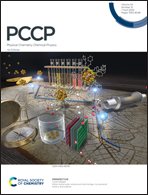A theoretical electronic structure with a feasibility study of laser cooling of LaNa molecules with a spin orbit effect†
Abstract
The electronic structure with the spin orbit effect of the molecule LaNa has been studied in the present work using the Multi-Reference Configuration Interaction MRCI calculations including Davidson correction (+Q). Adiabatic potential energy curves (PECs) have been investigated for the lowest low-lying spin free states in the Λ representation and spin orbit states of Ω = 0+/−, 1, 2, 3, and 4 along with their spectroscopic constants Re, Te, ωe, and Be, the dissociation energy De, the dipole moment μe, and the ionic character fionic of the LaNa molecule at the equilibrium bond length. The permanent dipole moment curves (PDMCs) for the investigated states are calculated in addition to the electronic transition dipole moments between the lowest electronic states where the Franck–Condon factor (FCF) has been calculated for the X1Σ+–11Π and for many spin orbit transitions. For these transitions the dipole moments are used in order to determine the Einstein coefficient of spontaneous emission Aν′ν, the radiative lifetime τ and the branching ratio Rν′ν. Employing the canonical function approach, the rovibrational parameters Eν, Bν, Dν, Rmin and Rmax have also been calculated for the lowest vibrational levels of different bound states in both Λ and Ω representations. To the best of our knowledge, the data reported in the present work are presented for the first time in the literature with a discussion on the candidacy of this molecule for laser cooling.



 Please wait while we load your content...
Please wait while we load your content...